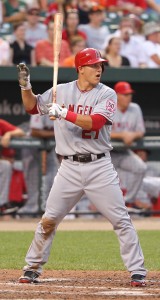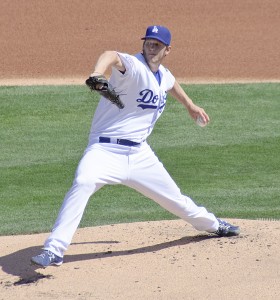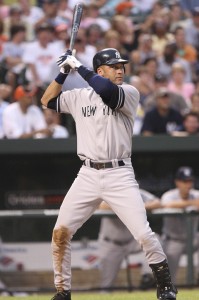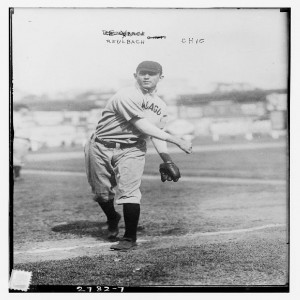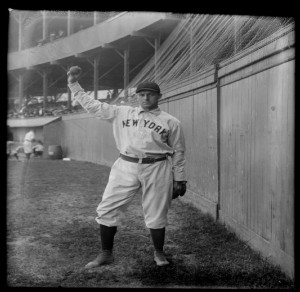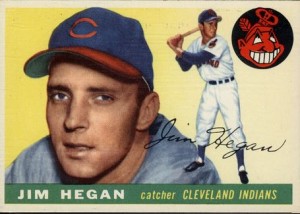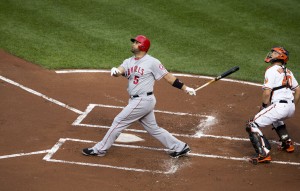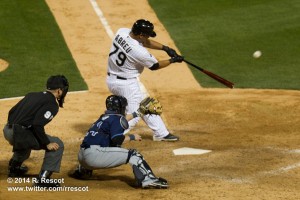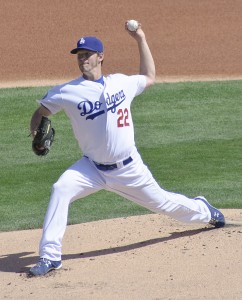September’s regular season games are on the books, the races are over and the post season lies ahead. That means it’s time for BBRT monthly and season-ending wrap up. (You’ll also find BBRT’s post-season predictions along the way.)
Most the MLB playoff teams showed their mettle in September. In the AL, the teams with the top-four September records (Orioles, Tigers, Royals and Angels) were all playoff bound. The only exception was the A’s, who held on to a Wild Card spot despite September’s AL-worst record. In the NL, the story was much the same, the top-four September records went to the Nationals, Cardinals, Pirates and Dodgers – all headed to the post season. The Giants, who complete the NL post-season lineup, finished September at 13-12. Clearly, the teams that make up this year’s slate of post-season contenders are nearly all entering the playoffs with positive momentum.
Here are your playoff teams and a look at September performance (full results with won-lost records for the season and month are listed are the end of this post).
American League
Division Champions: Orioles, Tigers, Angels. The Orioles continued to roll, putting up the AL’s best September record (17-10, .630 – following a 19-9 August and a 17-8 July), winning the AL East by 12 games. The Tigers won the Central Division title, finishing September with the AL’s second-best record (16-10, .615), topping the Royals by one game in the standings. The Royals tied the AL West champion Angels for the AL’s third-best September record at 15-11, .577.
Wild Cards: Royals, A’s. The Royals made the playoffs and challenged for the AL Central title, finishing strong by playing .577 ball in September (after sharing August’s MLB-best record with the Orioles at 19-9). The A’s limped into the post-season – capturing the second AL Wild Card spot on the final day of the season, despite an AL- worst record for September (10-16, .385).
National League
Division Champions: Nationals, Cardinals, Dodgers. The Nationals had MLB’s best record in September (19-8, .704), lengthening their lead to 17 games over the second-place Braves (who went a dismal 7-18, .280) for the month, dropping to 79-83 and a second-place tie with the Mets. The Cardinals took the Central title with a 17-9, .654 month (tied with the Pirates for the third-best September in the NL). The strong finishes for St. Louis and Pittsburgh, coupled with a late-season slump by the Brewers (9-17 in September), pushed Milwaukee (which led the division most of the season) out of the post-season picture. The Dodgers finished strong, with the NL’s second-best record at 17-8, .680. Arizona had MLB’s worst record for September (7-19, .269) and for the season (64-98, .395).
Wild Cards: Giants, Pirates. The Giants finished September 13-12 and took the final NL Wild Card spot.
The Early and Late of It
On September 15th, the Angels became the first team to clinch a 2014 play-off spot topping Seattle 8-1. The win gave the Angels a 94-68, .627 record – one of only two MLB teams playing .600 ball through September 15 (the other was the Baltimore Orioles at 90-60, .600). The following day, the Washington Nationals and Baltimore Orioles became the first teams to clinch 2014 division titles (the Angels clinched at least a wild card berth the day before, but did not wrap up the AL West title until September 17).
The last team to clinch a post-season berth was the Oakland A’s, who didn’t wrap up their spot until their last game of the season, beating the Rangers 4-0 to keep their one-game lead over the Mariners (who also won, beating the Angels 4-1).
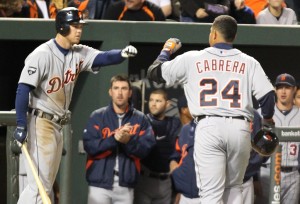
Despite a combination of power arms and power bats, The Tigers were the last team to clinch their division.
The last team to clinch their division was the Tigers. On the final day of the season, the Tigers topped the Twins 3-0, to maintain a one-game lead over the Royals, who beat the White Sox 6-4. The NL Central was nearly as close, with the Cardinals going into the final day with a one-game edge over the Pirates. The Pirates’ loss was on the books, assuring St. Louis the title, before the Redbirds shut out the Diamondbacks 1-0 to take the Division by two games.
On the Road Again
The Dodger finished with MLB’s best road record at 49-32, followed by the AL’s Royals (47-34.) The Orioles, Angels and Mariners round out the top five road teams, with 46 road wins each.
The Angels ran up the best home record at 52-29, followed by the Nationals, Cardinals and Pirates at 51-30. The Orioles were the only other team with 50 home wins (50-31).
Twenty-one of MLB’s 30 teams had winning records at home (nine in the AL, 12 in the NL); while ten teams had winning road records (seven in the AL, three in the NL).
Uniquely, every team in the NL Central had a winning home record and played below .500 on the road.
Season and September Batting Leaders
Number one on the hit parade this season was Astros’ 2B Jose Altuve, whose 225 hits and .341 average led all of MLB. Over in the NL, Rockies’ 1B Justin Morneau captured the batting crown at .319 (the second ex-Twin in the past two seasons to win the NL title after moving to the Rockies). The September batting leaders (minimum 50 plate appearances) were Dodgers’ LF Carl Crawford in the NL at .448, 30-for-67) and Indians’ LF Michael Brantley in the AL at .416 (42-for-101). They were the only two hitters to best .400 for the month.
Baltimore DH Nelson Cruz was the only MLB hitter to reach 40 home runs, topping the AL. Over in the senior circuit, Marlins’ RF Giancarlo Stanton (despite missing considerable time) was the league leader with 37 dingers. September’s HR leaders, for the most part, helped propel their teams to the play offs. Leading all hitters was Dodgers’ LF Matt Kemp with nine September round trippers. Following up with eight were Dodgers’ 1B Adrian Gonzalez, Tigers’ 1B Miguel Cabrera and Yankees’ C Brian McCann.
The Dodgers’ Adrian Gonzalez was the NL RBI leader for the season at 116 – and also tied teammate Matt Kemp for the highest September total at 25. In the AL, Angels’ CF Mike Trout led with 111 RBI on the season, with teammate 1B Albert Pujols topping the AL for September with 22 runs driven in.
In the speed department, Dodgers’ 2B Dee Gordon led the NL with 64 swipes (19 caught stealing); while Astros’ 2B Jose Altuve topped the AL with 56 steals in 65 attempts. Two players (one in each league) reached nine steals in September: Phillies’ CF Ben Revere (9-for-12) and Rangers’ CF Leonys Martin (9-for-11).
Pitching Leaders Season and September
Despite missing about a month of the season, Dodgers’ left Clayton Kershaw led all of MLB in victories at 21 (versus 3 losses) and ERA 1.77 (becoming the first pitcher to lead his league in ERA four consecutive years). There were two other 20-game winners, both in the NL, both right-handers and both at 20-9: the Cardinals’ Adam Wainwright and Reds’ Johnny Cueto Wainwright and Kershaw shared the NL (and MLB) lead in September wins, both running up five wins against no losses. The NL ERA leader for September (at least 20 innings pitched) was Cubs’ right-hander Jake Arrietta, with a 0.95 ERA in four starts. He was the only MLBer with an ERA under 1.00 for the month.
There was a three-way tie (all right-handers) for most wins in the AL: the Tigers’ Max Scherzer (18-5); Angels’ Jered Weaver (18-9); and Indians’ Corey Kluber (18-9). Seattle righty Felix Hernandez captured the AL ERA crown at 2.14, edging White Sox southpaw Chris Sale (2.17). For September, Kluber was the only Al pitcher to reach five wins (versus one loss), while the ERA leader for the month was Rangers’ left-hander Derek Holland at 1.46.
Tigers (and Rays) left-hander David Price led MLB in strikeouts with 271 in 248 1/3 innings, holding of the Indians’ Corey Kluber (269 Ks in 235 2/3 innings). There was a tie for the strikeout crown in the NL, with right-handers Johnny Cueto of the Reds (243 2/3 innings) and Stephen Strasburg of the Nationals (215 innings) each reaching 242 K’s. Kershaw, with seven fewer starts than the two leaders, fanned 239 (198 1/3 innings).
The Mariners’ Fernando Rodney led all closers with 48 saves (three blown saves), while Atlanta’s Craig Kimbrel led the NL with 47 saves (four blown saves). The runners-up in each league came from post-season qualifiers: the Royals Greg Holland (46 saves, two blown saves) and the Cardinals’ Trevor Rosenthal (45 saves, six blown saves). The Nationals’ Drew Storen was the only closer to reach 10 saves for the month of September (two blown saves), while Seattle’s Fernando Rodney topped the AL with nine September saves (no blown saves).
The Other Side of Leadership
No hitter struck out more times than Phillies’ 1B Ryan Howard this season (190 K’s in 569 at bats) – to go with a .223-23-95 line. The AL strikeout leader might surprise you – Angels’ star CF Mike Trout (184 K’s in 602 at bats). Even with all those whiffs, Trout hit .287, scored 115 runs, drove in 111, hit 36 homers, swiped 16 bases and is considered an MVP candidate. The September strikeout leader was Cubs’ 2B Javier Baez, who hit .149 for the final month, fanning 46 times in 101 at bats. Again, the AL leader in K’s for September might come as a surprise: Tigers’ outfielder J.D. Martinez, who fanned 34 times in 96 at bats, but still managed a .354 average for the month.
Nobody walked more hitters than Phillies’ righty A.J. Burnett (96 walks in 213 2/3 IP – but also 190 K’s). The AL leader in free passes was the Angels’ lefty C.J. Wilson (85 walks in 175 2/3 IP). Notably, the two hurlers had similar ERA’s (4.59 for Burnett, 4.51 for Wilson), but Burnett ended the season 8-18, while Wilson won 13 and lost 10. Burnett’s 18 losses led all of MLB, while the AL loss leader was Rangers’ righty Colby Lewis 10-14, Eight hurlers lost four games in September, with three teams having two four-game losers: Atlanta’s Mike Minor and Julio Teheran; San Francisco’s Tim Hudson and Ryan Vogelsong; Milwaukee’s Yovani Gallardo and Jimmy Nelson; Detroit’s Rick Porcello; Miami’s Nathan Eovaldi.
Before we look at a few September “tid bits” BBRT found interesting – here’s my post-season predictions.
AL Wild Card play-in. A’s reverse their September course behind Lester and knock off the Royals.
ALDS: Angels too strong for A’s. Tigers edge Orioles.
ALCS: Detroit starting pitching the difference as Tigers move on to World Series.
NL Wild Card play-in: Giants over Pirates.
NLDS: Nationals too much for Giants. Dodgers’ pitching shuts down Cardinals’ offense.
NLCS: Kershaw/Grienke the difference as Dodgers go to World Series.
World Series: Tigers in seven, good pitching both sides. LA pitches around Miguel Cabrera, but Victor and J.D. Martinez light up Tiger offense.
A Few September Tid Bits
Where Have All the Starters Gone?
Jordan Zimmerman put an exclamation point on the Nationals NL-East leading 2014 season, tossing a no-hitter on the season’s final day. Zimmerman walked just one and struck out ten in the 1-0 victory over the Marlins. The no-hitter was saved by a spectacular leaping catch (with two out in the ninth) by Nats’ LF Steven Souza, Jr., who had come into the game as a defensive replacement for Ryan Zimmerman. In fact, all seven Nationals’ fair-territory fielders when the game ended were defensive replacements – only Zimmerman and catcher Wilson Ramos remained in place from the original lineup. ELIAS indicated this is the first time that has happened in an MLB no-no.
Here are a few other tid bits about the no-hitter: It was the fifth no-hitter thrown on the final day of an MLB season; the fifth no-hitter of the 2014 season (all in the NL); and the fifth no-hitter in the history of the Expos/Nationals.
Under Control
One September 24, Twins’ hurler Phil Hughes beat the Arizona Diamondback 2-1 in Minneapolis – giving up one run on five hits in eight innings pitched. It gave Hughes a 16-10 record and 3.52 ERA for a Twins team that ended the season 70-92. In his final start of the 2014 campaign, Hughes did not walk a batter, while striking out five – and that proved significant. On the season, Hughes pitched 209 2/3 innings (more on that later), striking out 186 versus only 16 walks. That gave Hughes a strikeout-to-walk ratio of 11.63 on the year – the highest single-season strikeout-to-walk ratio (among pitchers with qualifying innings) in MLB history. Bret Saberhagen had the previous record at 11.00 in 1994. That 209 2/3 innings pitched is also significant. Hughes needed to log 210 innings to earn a $500,000 bonus (he had already earned bonuses at two previous IP levels, but left the game 1/3 inning short of the next bonus level following a one-hour- plus rain delay). The Twins did offer Hughes a chance to pitch in relief in the final days of the season, but he declined, indicating it was more important to protect his health for 2015. And, no whining, either. Class act!
A Walk-Off Walk-Off
One September 25, Derek Jeter played his last game in Yankee Stadium – and he put a typical Jeter touch on his final at bat there – hitting a game-winning, walk-off RBI single in the bottom of the ninth (giving New York a 6-5 win).
Eight Straight and Then the Pitcher
On September 15, New York Mets’ rookie Jacob deGrom got off to a blazing start – striking out the first eight Miami Marlins he faced and tying the MLB modern-day record for strikeouts to start a game. Ironically, the string of whiffs was broken on a base hit by the opposing pitcher Jarred Cosart – just another reason I don’t like the DH. DeGrom went seven innings, giving up three runs on six hits, while striking out one and fanning thirteen.
For the Tie and the Win
On September 8, the Chicago White Sox were down to their last strike, trailing the Oakland A’s 4-3 with two outs in the bottom of the ninth and a 2-2 count on C Tyler Flowers. Flowers, however, delivered a home run down the left field line, sending the game into extra innings. Flowers was not done yet. In his next at bat, in the bottom of the twelfth inning, he hit the first pitch to him from reliever Jesse Chavez for a walk-off, game-winning round tripper.
The Hit (By Pitch) Parade
On September 12, Marlins’ right fielder Giancarlo Stanton was leading the NL in home runs (37) and RBI (105), when he came to the plate in the top of the fifth inning (facing Brewers’ right-handed pitcher Mike Fiers) with two outs and runners on the corners. On an 0-1 count, Fiers threw an 88- mile-per-hour fastball that ran up and in as Stanton turned toward the pitch. The pitch struck Stanton below the left eye, resulting in a bloody laceration, multiple fractures and dental damage.
First-base umpire D.J. Reyburn ruled that Stanton was swinging at the pitch, so – after Stanton was carried from the field – pinch hitter Reed Johnson came to the plate with an 0-2 count. That’s when things got even more intense – and strange. Fiers first pitch to Johnson hit him on the right hand and the umpires again ruled that the hitter (Johnson) was swinging – resulting in a strikeout (logged against Stanton’s record). The benches cleared, warnings were issued and a couple of ejections (Marlins’ Manager Mike Redmond and 3B Casey McGehee) ensued. Meanwhile, what looked on the surface like a pair of hit batsman went into the record books as a strikeout for Fiers.
In the sixth inning, tempers remained hot and Marlins’ acting manager Rob Leary and pitcher Anthony DeSclafini were ejected after DeSclafani hit the Brewers’ Carlos Gomez with a pitch (left elbow).
September 12 turned out to be a pretty “wild” day on the mound and in the batters’ box across major league baseball – with 15 hit batsmen in 11 games (and, remember, Stanton and Johnson did not go in the books as “hit by pitch”). Here’s a little wrap up of the HBPs for the day:
- Carlos Gomez hit by Anthony Desclafini after the Stanton injury.
- The Mets’ Bartolo Colon hit the Nationals’ Ian Desmond (the first batter after Colon gave up a first-inning home run to Adam LaRoche. Then, in the fourth inning, Colon hit Jayson Werth with a pitch after giving up a home run to Anthony Rendon. (Colon and Mets’ manager Terry Collins were ejected.) In the eighth inning, the Nationals’ Matt Thornton hit the Mets’ Daniel Murphy.
- The Rangers’ Nick Martinez hit Mike Trout with pitches in the third and fifth innings of the Angels 7-3 win in Texas. Angels’ reliever Joe Smith hit the Rangers’ Tomas Telis with a pitch to lead off the bottom of the ninth, resulting in a warning to both benches.
- The Royals’ Liam Hendriks hit the Red Sox’ Yoenis Cespedes in the top of third inning of Boston’s 6-3 win. The Red Sox’ Clay Buchholz hit Royals’ outfielder Josh Willingham in the back leading off the sixth inning of the same game.
- The Rays’ Brad Boxberger hit the Yankees’ Derek Jeter on the elbow in the eighth inning of the Rays’ 5-4 loss to NY. In the ninth, the Rays’ Jake McGee hit Yankee 3B Chase Headley.
- The Indians’ T.J. House hit the Twins’ 2B Brian Dozier in the top of the sixth inning of the Indians’ 2-0 win in the second game of a double header.
- The Reds’ Johnny Cueto plunked the Cardinals’ Jon Jay in the top of the first in the Reds’ 1-0 home win.
- The Giants’ Javier Lopez hit the Diamondbacks’ Cliff Pennington in the top of the eighth, as SF topped Arizona 6-2.
- The Phillies’ A.J. Burnett hit the Pirates’ Stirling Marte in the second inning of the Pirates 4-1 victory.
Thanks, Dad
On September 14, Giants’ manager (and former major league catcher) Bruce Bochy became the first manager to call in his own son from the bullpen. It came in the sixth inning, and Bochy showed no favoritism to his son Brett – bringing him in for his major league debut with the bases loaded. Brett, who ran up a record of 14-8,with a 3.03 ERA in four minor league seasons, walked in a run before logging the final out of the inning, and then allowed a two-run home run to Scott Van Slyke (also the son of a former major leaguer – Andy Van Slyke) in the seventh. The first-place Dodgers trounced Bochy’s second-place Giants 17-0.
Whiff City
The Cleveland Indians’ pitching staff missed a lot of bats this season, fanning an MLB record 1,450 hitters– helping MLB pitchers set a season strikeout record of 37,441.
Hmm?
The Saint Louis Cardinals’ pitching staff led all of baseball with 23 shutouts in 2014 – yet their league-leading complete game total was just eight. Tampa Bay which had an AL leading 22 shutouts, had only three complete games. #HowTheGameHasChanged
Some other team leaders.
Batting Average: AL – Tigers .277 NL – Rockies .276
Runs Scored: AL – Angels 773 NL Rockies 755
HRs: AL – Orioles 211 NL – Rockies 186
Stolen Bases: AL – Royals 153 NL – Dodgers 138
ERA: AL – Mariners 3.17 NL – Nationals 3.03
Final Standings and September Records
TEAM W L PCT GB (Sept/)
AL East
Baltimore 96 66 .593 (17-10)
NY Yankees 84 78 .519 12.0 (14-13)
Toronto 83 79 .512 13.0 (14-12)
Tampa Bay 77 85 .475 19.0 (11-14)
Boston 71 91 .438 25.0 (11-15)
AL Central
Detroit 90 72 .556 (16-10)
Kansas City 89 73 .549 1.0 (15-11)
Cleveland 85 77 .525 5.0 (14-13)
Chicago WS 73 89 .451 17.0 (11-14)
Minnesota 70 92 .432 20.0 (11-14)
AL West
LA Angels 98 64 .605 (15-11)
Oakland 88 74 .543 10.0 (10-16)
Seattle 87 75 .537 11.0 (14-13)
Houston 70 92 .432 28.0 (11-13)
Texas 67 95 .414 31.0 (14-12)
NL East
Washington 96 66 .593 (19-9)
Atlanta 79 83 .488 17.0 (7-18)
NY Mets 79 83 .488 17.0 (15-10)
Miami 77 85 .475 19.0 (11-16)
Philadelphia 73 89 .451 23.0 (11-15)
NL Central
St. Louis 90 72 .556 (17-9)
Pittsburgh 88 74 .543 2.0 (17-9)
Milwaukee 82 80 .506 8.0 (9-17)
Cincinnati 76 86 .469 14.0 (10-15)
Chicago Cubs 73 89 .451 17.0 (12-13)
NL West
LA Dodgers 94 68 .580 (17-8)
San Francisco 88 74 .543 6.0 (13-12)
San Diego 77 85 .475 17.0 (13-14)
Colorado 66 96 .407 28.0 (12-13)
Arizona 64 98 .395 30.0 (7-19)
